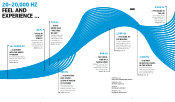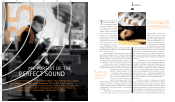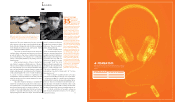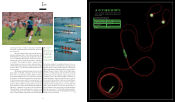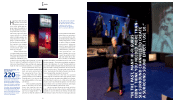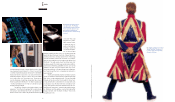Sennheiser 2012 Annual Report Download - page 14
Download and view the complete annual report
Please find page 14 of the 2012 Sennheiser annual report below. You can navigate through the pages in the report by either clicking on the pages listed below, or by using the keyword search tool below to find specific information within the annual report.
26
300 Hz
300 Hz
ARCHAEOACOUSTICS
27
In the green upper reaches of
the Peruvian Andes, more
than 10,000 feet above sea
level, lies a mysterious ancient
gathering place called Chavín
de Huántar. Its stone plazas
and temples are now covered in
moss, but their grand scale and
detailed bas-relief carvings testify to their one-time signifi-
cance. As with another famous Peruvian site, Machu Picchu,
Chavín’s exact purpose has long eluded historians and ar-
chaeologists because its creators left behind no written re-
cords. But while we may never experience Chavín exactly the
way the ancients did, archaeoacoustics researcher Miriam
Kolar and other sound detectives from Stanford’s Center for
Computer Research in Music and Acoustics (CCRMA) have
shed light on some possible reasons for its existence. Using
state-of-the-art technical equipment, they have been able
to demonstrate how an engraved stone monolith at the site
could have served as a hidden oracle that “spoke” to people
listening outside in a sunken plaza.
“A person who had access to it would be in the
company of a small number of people,” says Kolar. When
Kolar had the opportunity to conduct sound experiments at
Chavín, once a center of spirituality for ancient peoples all
over the region, she jumped at the chance. Formerly a
sound designer and recording engineer in Los Angeles, Ko-
lar is familiar with how the layout of interior spaces can
affect the quality of sound transmission and how a space’s
acoustics can shape a listener’s experience. “Archaeology
offers the perfect opportunity to study the human effects
of acoustics,” she says. “We’re interested in the whole an-
cient landscape of human experience.” How might it have
been to visit Chavín 3,000 years ago – what might listeners
have heard there and what psychological effects might the
sound have produced? Kolar’s cultural acoustics research
seeks to answer these questions.
While structures at other noted archaeological
sites are often crumbling, the buildings at Chavín still have
many interior rooms and corridors intact. Some of the pas-
sageways are so narrow and labyrinthine, they make the
outside world seem light-years
away. “Since these galleries
are so deep within the build-
ings, in many places no light
can come in from the outside,”
says Kolar, as she explains her
undertaking.
Before Kolar made her
first trip to Chavín, her team equipped an archaeologist with
a customized acoustics field kit. When taking his first
on-site measurements, John Rick employed a compact
Neumann loudspeaker to play back powerful test signals in
the subterranean chambers. He then used in-ear micro-
phones equipped with Sennheiser KE4 capsules to record
the signals, which enabled the researchers to gather infor-
mation on the sound-transmission qualities of the rooms
and corridors. The information was
then sourced to develop a digital
acoustic model of the galleries.
Kolar, who formed the team
together with colleague Jonathan
Abel, visited Chavín for the first
time in 2008. Once on site, she
grew so immersed in recording and analyzing its acoustical
properties that she made Peru her research base. “Until you
get into the space yourself, you can’t really understand it,”
she says. “Moment to moment, your psychological and
physical states alter your perception.”
As Kolar explored the space, she focused her atten-
tion on a sculpture deep inside the temple complex – a
4.5-meter-high stone monolith decorated with fangs and
twisting snakes: “el lanzón” or “the lance.” She noticed that
the carved mouth of this stela was almost perfectly aligned
with a corridor and a horizontal duct leading to a sunken
circular plaza beyond the temple. Was it possible that this
corridor and the two parallel ducts were able to transmit
and amplify the sound like some ancient loudspeaker? The
recordings made by her on site showed that “there’s a direct
line of sound from the mouth of the carved monolith all the
way to the world outside.” Kolar continues, “The question is
whether it can be heard there.”
e1. The corridors and ducts are
disorienting and claustrophobic.
b2. Tenon-heads like these are
thought to represent stages
of a human-to-feline shamanic
transformation.
“THERE’S A DIRECT LINE OF SOUND FROM
THE MOUTH OF THE CARVED MONOLITH
ALL THE WAY TO THE WORLD OUTSIDE.”


